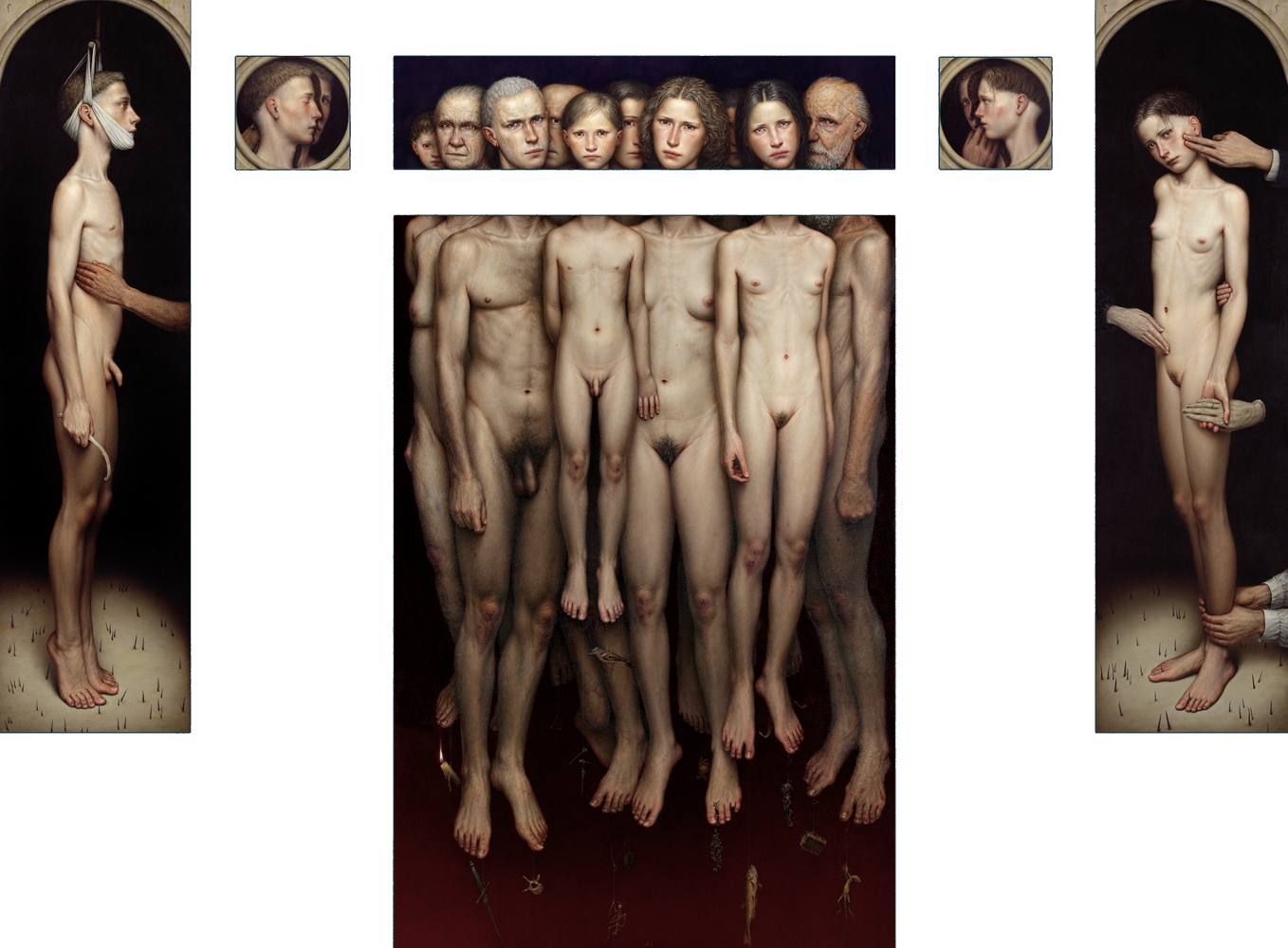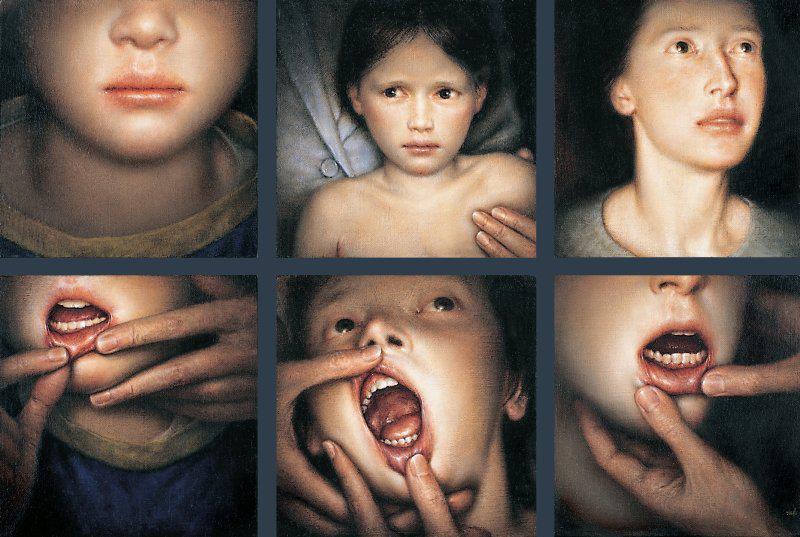For research I wanted to look into more modern symbolist artists as well as older ones to get examples of the old and the new of this movement.
I have been aware of Dino Valls work for a few years now and he's an artist that is difficult to forget in skill and subject matter. I thought his paintings were the work of digital age but his work has introduced me to the technique of egg tempra which I would like to try in the future. He's been picked for research because of the effect his work has on me and how he portrays the human body and psyche in a beautifully disturbing manner. How he is able to explore the symbolism and world he creates for his figures and show us places we thought were only in our deepest thoughts.
Dino Valls (Spanish, figurative, symbolism, 1959-) His painting, elaborating and expanding the methods of past masters, centers on the human psyche by using figurative techniques only as a formal support in which to project a conceptual content laden with profound psychic weight, where the most obscure pulsations develop in a symbolic process of intellectualism.
Having previously obtained a degree in
medicine, he is now one of the Spanish representatives of the vanguard of
figurative art. His painting, elaborating and expanding the methods of past
masters, centers on the human psyche by using figurative techniques only as a
formal support in which to project a conceptual content laden with profound
psychic weight, where the most obscure pulsations develop in a symbolic process
of intellectualism. He has participated in important international exhibitions
of contemporary art, and has held numerous showings in Europe and the United
States.
He is a self-taught artist with an early
involvement in drawing. He began painting oil in 1975. During his medical
studies at the University of Zaragoza, he continued his painting and submitted
his work to various art competitions in Spain and France, where he receive
several awards.His first one-man exhibition was received in Zaragoza in 1981. The following year he was awarded the San Jorge First Place Award in Painting, after receiving his degree in medicine and surgery in 1982, he decided to devote himself exclusively to painting; the kind of painting which would be influenced by the humanistic perspective that brought about the study of man. This kind of attitude is reminiscent of the creative climate of the Renaissance.
In 1987 he was select by the Ministry of foreign affairs to participate in the exhibition of Contemporary Spanish Art in Germany and had a one-man exhibition in the Heller Gallery in Madrid, a city where he has lived since 1988.
His passion for ancient painting moved him to study seriously the techniques of the great masters in the major European museums. In the mean time, he continued to participate in one-man and group exhibitions.
Barathrum
In 1991 Valls studied the art of egg tempera and the technique of the Italian and Flemish masters of the 16th and 17th centuries. Egg tempera remains his favorite technique for painting. In 1993 Valls began participating in various U.S. art fairs in Miami, New York, South America and Australia.
Art is the only medium which allows man to unite his logical thought and his magical thought, redeeming him from the profound dichotomy which exists between both. Curiosity incites us to step out into the field of logic, raising our gaze beyond what may be recognized. This may be the point of inflection which leads us unreality in Dino Valls' painting.
One of the privileges by those dedicated to art is that related to a special form of possession. Although a person's desire to grasp another may never be completely fulfilled, being able to create an image the possession of which begins and ends strictly in the actual creation, is an eminently artistic prerogative, that in addition to being much more satisfactory, accompanies another aspect which is not of less importance: he concept of endopathy, according to which, in order to paint a figure, one has to become it. Just as all paintings are self-portraits, only mirrors hang on the walls, which means an extension of the relation between participation and effect upon each other by the work of art, the author and the spectator.

Mysterium Coniuncationis
The gaze discovers the painting and this reveals what we only know intuitively: the irrational. It is during our attempt to rationalize it that the conflicts arises, originating in our collective cultural unconsciousness, which scientific research continues to try to unmask.
Just as dreams disguise themselves as reality to make themselves recognizable for the consciousness, Dino Valls` painting conceives his artistic ideas based on the artist's interior unreality. Neither realism as naturalism, nor a fleeting personal view of the real world concern him. It is not the exterior and its objective reality that attract him, but rather the contrary. This is a search inside oneself, plunging into the warehouse of what underlies everyday experience. In his work, the painter reveals these profound conflicts, and the spectator recognized them as part of his internal struggle, as they belong to the same human essence.
Alicia Guixa, Catalogue, "Dino Valls", Madrid (December 1993)
Introitus
The sample below taken from his website could explain his work better than I could.
Fernando Castro Florez
(Professor of Aesthetics and Art Theory at the Universidad Autonoma de Madrid, art critic and curator
(...) We could understand the whole aesthetic of Valls as a kind of
speculation about the condition of the contemporary subject. His paintings are mirrors in which anxiety is settled and the painful process of split personality. The darker monster is actually inside us. The most beautiful bodies and even "angelic" are wounded and since especio of representation, challenge us. Images in apostrophe in the faces impose abysmal dimension or better, medusea of gaze.
We can not escape the gaze shocked or disturbed painting figures Dino
Valls, those eyes are on the verge of something we do not understand, as
if waiting for something that we can not do.
His symbols allegorize the unconscious drives appoint tangentially
allude to transformation processes, retake a thought that goes beyond
the crosslinking exerted by the rational. (...)
(...) Experts often revel in his technique and especially with what he describes as "immaculate brushwork", to which the artist replies that it is just the opposite: "My painting serves to bring darkness, anxiety, torment. What I do as an artist is to delve into the darkest and most unknown of man. My painting would come to be a way to spot the white ". He wants to enter a dark, disturbing represent what (in the Freudian sense something strange has become familiar because of the repression) and, ultimately, reflect the unconscious. This painting is crossed by the anguish has paradoxically extreme beauty. Conflicts of existence are not or are used literalized rhetoric typical of the "culture of complaint" but our condition is allegorized painful but at the same time, there arises a kind of vast power of the symbolic as if art still have the ability to offer redemption or at least an old guard "promise of happiness." Active imagination, to use Jungian terms, deployed by Dino Valls offers an impressive and multiple (self) portrait in which plunges this tradition both in terms of projects up to the fantastic, the unreality of the friction seen entering with the enigmatic presence of looks that seem to have more life to all those with whom we come across daily. Dissection of the unconscious through naked bodies, ie fur that may be too deep, a figuration that (we) transforms and trapped in an oscillation of the mythological to the dream. Dino Valls is very right when he says that "a work of art weighs as much as the volume it displaces unconscious."
Test "The weight of the Unconscious. An approach to symbolism transformer
Dino Valls " , for the catalog of the retrospective exhibition "Dino Valls" Frissiras Museum, Athens, November 2011.
(...) Experts often revel in his technique and especially with what he describes as "immaculate brushwork", to which the artist replies that it is just the opposite: "My painting serves to bring darkness, anxiety, torment. What I do as an artist is to delve into the darkest and most unknown of man. My painting would come to be a way to spot the white ". He wants to enter a dark, disturbing represent what (in the Freudian sense something strange has become familiar because of the repression) and, ultimately, reflect the unconscious. This painting is crossed by the anguish has paradoxically extreme beauty. Conflicts of existence are not or are used literalized rhetoric typical of the "culture of complaint" but our condition is allegorized painful but at the same time, there arises a kind of vast power of the symbolic as if art still have the ability to offer redemption or at least an old guard "promise of happiness." Active imagination, to use Jungian terms, deployed by Dino Valls offers an impressive and multiple (self) portrait in which plunges this tradition both in terms of projects up to the fantastic, the unreality of the friction seen entering with the enigmatic presence of looks that seem to have more life to all those with whom we come across daily. Dissection of the unconscious through naked bodies, ie fur that may be too deep, a figuration that (we) transforms and trapped in an oscillation of the mythological to the dream. Dino Valls is very right when he says that "a work of art weighs as much as the volume it displaces unconscious."
Test "The weight of the Unconscious. An approach to symbolism transformer
Dino Valls " , for the catalog of the retrospective exhibition "Dino Valls" Frissiras Museum, Athens, November 2011.
Dies Irae 2012




No comments:
Post a Comment